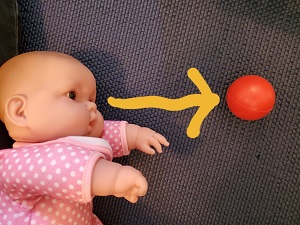10 Ways To Teach Your Baby To Roll
There are affiliate links in this article. If you purchase items through these links, I will receive a small compensation to pay for the costs associated with maintaining this blog and website. Please see my Disclaimer policy for more information
Some babies learn to roll over easily and others struggle. By four months of age, most babies can roll from their back to their side. By six months of age, most can roll from their back to their tummy and from their tummy to their back. If your baby was born prematurely, remember to use the adjusted age.
If your baby struggles to master this important motor skill, here are 10 expert tips that should help:
- Lots of tummy time – Many babies who hate tummy time struggle with rolling. Not all, but many. The reason is often lack of practice. When your baby hates tummy time, they do not spend time learning how to roll out of the position and, therefore, do not develop the necessary strength and coordination. Read my 10 Tips for Happy Time.
- Full neck range of motion – Some babies cannot turn their heads in both directions due to torticollis, positional plagiocephaly, or weakness. Your baby needs to be able to fully turn the head to master rolling in both directions. Is your baby developing flat spots on their head? Read my 10 Ways to Avoid the Baby Helmet. How do I check for neck tightness? Click here.
- Playing in side-lying – Many babies spend most of their waking hours, lying on their backs under a mobile, placed on the tummy, or in a baby holding container, such as a car seat. But, laying them on the side (do both right and left sides) allows your baby to use different muscles— muscles needed to roll over. You will probably have to help them stay in side-lying by repositioning them as needed.
- Play on a firm surface – Soft, fluffy blankets or pads create too much work for your baby. Imagine yourself trying to get out of a slightly deflated air mattress. It is hard! Use foam playmats or heavy quilts that do not bunch up for your baby to practice rolling over on.
- Practice when your baby is content – This is especially true if your baby struggles with tummy time. Practice a few minutes a few times a day. Set up a schedule.
- Use toys your baby loves – With your baby lying on their side, you want to entice them to reach for a preferred toy. The reaching motion will often encourage them to roll over to get the toy. If your baby does not want the toy, they will not put out much effort to get it. Here is a video of what I am talking about.
- Baby needs flexible legs – Rolling over requires your baby to rotate the lower half of their body. If your baby’s legs are stiff, do some gentle bicycle stretches to help with this. Video here.
- Baby needs strong abdominal muscles – It is cute when your baby can lift their legs and reach their toes. When your baby can lift their legs and reach their own feet, it indicates strong abdominal muscles. Here is a video to help with this.
- Toys at the correct angle– It is important to place the toys in certain positions. As your baby reaches, certain muscles will activate. To get the correct muscles to activate, toy placement is important. (See image below)
- Rotational stretching of your baby’s torso –Many babies that hate tummy time or spend lots of time in a carrier are tight in their torso muscles. Here is a gentle stretch you can try to help your baby roll. WATCH here.

These suggestions are offered as general advice and may not work for your particular situation. If your baby or you continue to struggle, seek direct assistance from a pediatric physical therapist. If your baby is under the care of a physical therapist, share with them any of these ideas you are trying to ensure your child’s therapist agrees.
To keep up with the latest tips and ask questions in real-time, join the Grow with Ginny Instagram community.
(Photo credit: Adobe Stock and Ginny Cruz)

